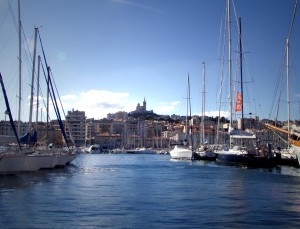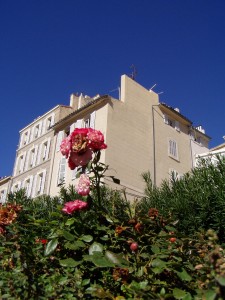
*Marseille (play /mɑrˈseɪ/; also Marseilles in English; French pronunciation: [maʁsɛj]; locally [mɑχˈsɛjɐ]; in Occitan Marselha or Marsiho [maʀˈsejɔ, maʀˈsijɔ]), known in antiquity as Massalia (from Greek: Μασσαλία),[1] is the second largest city in France, after Paris, with a population of 852,395 within its administrative limits on a land area of 240.62 km2 (93 sq mi). The urban area of Marseille extends beyond the city limits with a population of over 1,420,000[2] on an area of 1,204 km2 (465 sq mi). 1,530,000[3] or 1,601,095[4] people live in the Marseille metropolitan area, ranking it 3rd among French metropolitan areas after Paris and Lyon. Located on the southeast coast of France on the Mediterranean Sea, Marseille is France’s largest commercial port and largest French city on the Mediterranean coast. Marseille is the capital of the Provence-Alpes-Côte d’Azur region, as well as the capital of the Bouches-du-Rhône department. Its inhabitants are called Marseillais.
Marseille enjoys a Mediterranean climate. The summer holiday season lasts for six months, from May to October, although also in April sometimes there are temperatures above 20 °C (68.0 °F). Winters are mild, with average temperature 12 °C (54 °F) during the day and 4 °C (39 °F) at night during the months of December, January and February.

The city’s main thoroughfare, the wide boulevard called the Canebière, stretches eastward from the Old Port (Vieux Port) to the Réformés quarter. Two large forts flank the entrance to the Old Port—Fort Saint-Nicolas on the south side and Fort Saint-Jean on the north. Further out in the Bay of Marseille is the Frioul archipelago which comprises four islands, one of which, If, is the location of Château d’If, made famous by the Dumas novel The Count of Monte Cristo. The main commercial centre of the city intersects with the Canebière at rue St Ferréol and the Centre Bourse (the main shopping mall).
The centre of Marseille has several pedestrianised zones, most notably rue St Ferréol, Cours Julien near the Music Conservatory, the Cours Honoré-d’Estienne-d’Orves off the Old Port and the area around the Hôtel de Ville. To the south east of central Marseille in the 6th arrondissement are the Prefecture and the monumental fountain of Place Castellane, an important bus and metro interchange. To the south west are the hills of the 7th arrondissement, dominated by the basilica of Notre-Dame-de-la-Garde. The railway station—Gare de Marseille Saint-Charles—is north of the Centre Bourse in the 1st arrondissement; it is linked by the Boulevard d’Athènes to the Canebière.
On 16 September 2008, the Marseille-Provence project was selected to become the European Capital of Culture in 2013de la culture 2013.
________
*from wikipedia